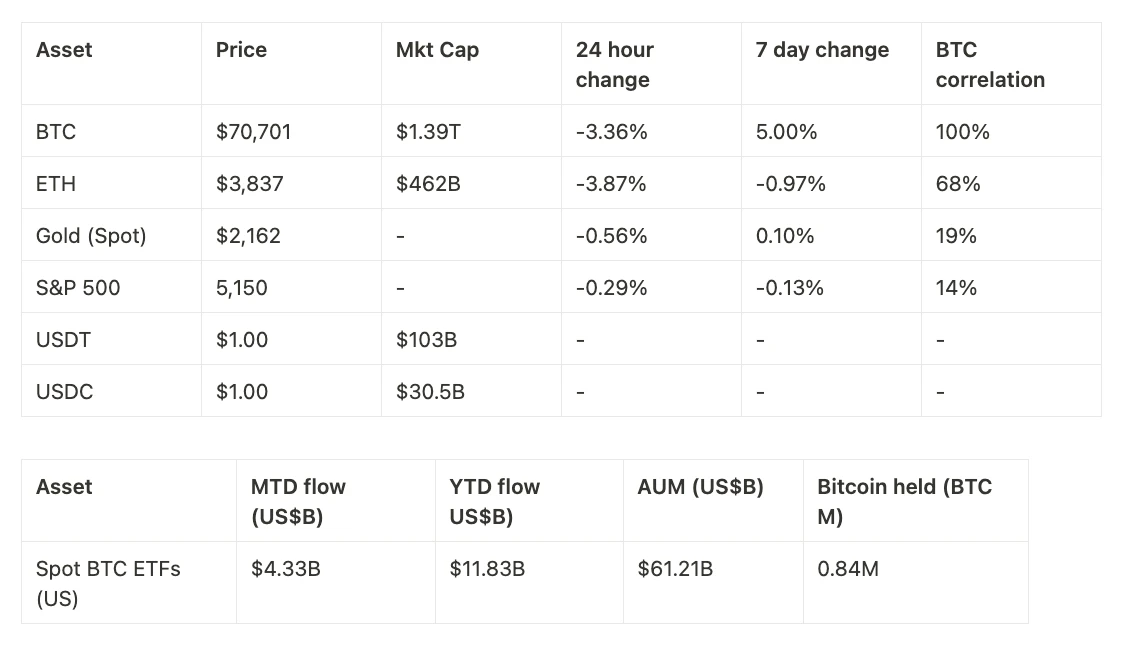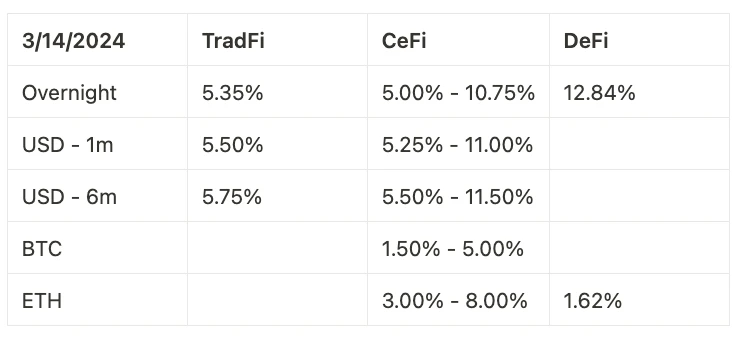Original title: Weekly: Divergent Destinations
Original author: David Duong (Institutional Research Director), David Han (Institutional Research Analyst)
Release date: March 15, 2024

quick overview
Bitcoin remains the anchor of the crypto asset class, but now that investors have a variety of options to gain exposure to the token, the performance of these options has clearly diverged since February.
Since the ETFs launch, MicroStrategys annualized volatility has been 130%, more than double that of the spot Bitcoin ETF and Bitcoin (55%).
Ethereum successfully completed the Dencun fork on March 13. We believe this is a solid step towards realizing the vision of Ethereum L2 expansion.
market observation
Crypto seems to have only one story at the moment, with crypto outperforming stocks on a risk-adjusted basis due to heightened emotions and herd mentality (the original article used the term Animal Spirits to describe it). Bitcoin remains the anchor of the asset class, but currently, investors have a variety of options to gain exposure to it. Now, market participants can not only buy (1) Bitcoin (BTC) directly, but also leverage (2) spot Bitcoin ETFs, or purchase (3) Bitcoin proxies such as MicroStrategy (MSTR) or (4) Bitcoin Mining mine. Interestingly, the performance of these options has diverged significantly since late February. From January 11 (the official launch of the spot Bitcoin ETF in the U.S.) to March 14, Bitcoin (based on the CME Bitcoin Reference Rate) gained 57%, and the ETF followed suit with an AUM weighted return of 59%. At the same time, miners performed poorly, losing 8%. MSTR was the top performer, with a return of 192%, more than 3 times the return of spot Bitcoin.

MicroStrategy (MSTR)
MicroStrategy is a significant holder of Bitcoin, making its stock performance highly sensitive to fluctuations in the currencys price. According to data disclosed by executive director Michael Saylor as of March 10, the company held more than 205,000 BTC at an average price of $33,706 each, and today their position costs approximately $6.9 billion. We believe MSTRs outperformance compared to other Bitcoin betas reflects in part the markets confidence in the companys borrowing strategy, while they improved their expense ratio by reducing total operating expenses in 2023, according to their latest 10-K filing. The ease of purchasing and storing MSTR in a brokerage account may also be a factor. Of course, investing in MSTR gives investors visibility into the companys business performance and any decisions made by its management.
Public Bitcoin Mining
Similar to MicroStrategy, shares of Bitcoin mining outfits can be purchased through brokerage firms and provide exposure to Bitcoin without direct ownership. However, their business performance depends on production costs (electricity, hardware, etc.) as well as Bitcoin difficulty adjustments such as the upcoming April halving. We believe that mining stocks have not followed Bitcoin’s upward trend in recent weeks for several reasons. First, miners have been selling their Bitcoin reserves to increase liquidity ahead of the halving, which is when market participants are trying to accumulate Bitcoin. Second, their revenue will be reduced in just over a month, although we believe this should have been factored into pricing expectations since the halving was planned and foreseeable in advance. Third, the U.S. government is proposing to tax the mining industry, although Congress has not passed similar provisions in the past. Regardless, we believe that in the period following the halving we could see a re-coupling of the correlation between the performance of mining stocks and Bitcoin itself.
Spot Bitcoin ETF
Over the past two months, we have delved into the importance of U.S. Spot Bitcoin ETFs and their value as an investment in Bitcoin through a regulated financial product. However, the fees for these ETFs vary, ranging from 0.20% to 1.50%, although most funds have lower referral fees (some funds have zero fees). BlackRock’s iShares Bitcoin Trust (IBIT) appears to have attracted the largest share of net inflows into these products, exceeding $12 billion since inception. ETFs directly track the price of Bitcoin, but have varying degrees of premium or discount to net asset value (NAV) due to operational factors, timing differences, and supply and demand constraints. This may explain why there is a small performance gap compared to trading Bitcoin directly.
Own Bitcoin directly
Purchasing Bitcoin avoids the management fees or rates associated with other Bitcoin beta investments. However, owning Bitcoin directly involves other considerations, such as custody (whether self-managed or through a third-party escrow), potential transaction fees when buying and selling, and the risk of security breaches in personal wallets. On the other hand, it is the cheapest means of gaining exposure to Bitcoin in the long run, and users have full control over their private keys, eliminating the potential complexities of gaining exposure to Bitcoin through other means.
Of course, payoff is only part of the story. Since the ETFs launch, MicroStrategys annualized volatility has been 130%, more than double that of the spot Bitcoin ETF and Bitcoin itself (55%). Compared to last year, its growth also exceeds that of Bitcoin, as MSTR’s previous annualized volatility was 81%, while Bitcoin’s annualized volatility in 2023 is 45%. MicroStrategys higher volatility is explainable because it takes on credit risk and the additional business risk of being a public company on top of its Bitcoin price exposure. In fact, Bitcoin miners are in a similar situation, with annualized volatility this year of 110%. In contrast, spot Bitcoin ETFs (and buying Bitcoin directly) will only be exposed to crypto market volatility in most cases.
On the chain: Dencun
Ethereum successfully completed the Dencun fork on March 13, which may be the most complex technical upgrade in history. Out of a total of nine Ethereum Improvement Proposals (EIPs), this fork contains more EIPs than any upgrade since the Byzantine fork in 2017. That said, most EIPs are developer-focused, with most attention focused on EIP-4844: Proto-Danksharding and its impact on Layer 2 (L2) fees. EIP-4844 introduces Blob storage, a new transaction type tailored for publishing L2 data at a lower cost. We introduced the details of EIP-4844 the previous week, as well as the relatively underrated EIP-7514.
The successful migration of Optimism and Base L2 (via their own Ecotone upgrade) following the mainnet transition to Dencun demonstrates the long-term potential of Ethereum’s scalability roadmap. After launch, these L2 transaction fees dropped to a tenth of a cent within a few hours, lower than most high-performance integrated blockchains. Transaction fees for other migrated L2s such as Arbitrum, zkSync and Starknet have also dropped several times, while other L2s such as Scroll and the Polygon zkEVM series are also preparing to switch in the coming weeks. All in all, we believe this is a solid step towards realizing Ethereum’s L2 scaling vision.
That said, these early stages of cheap blob pricing are unlikely to persist as more L2 comes online and competes in the market bidding for storage. As we publish this weekly report, the base gas fee for blobs has not yet increased from its initial value, as the blob count per block is still below the target of 3 (up to 6) per block, although it is getting closer to that threshold (see Figure 2). In the highly competitive blob market ahead, we still believe there will be room for alternative data availability solutions that cost less than large-scale blob storage. Additional sources of congestion on a single L2 (such as at the execution layer) may drive up transaction fees due to its increased on-chain usage, so it still makes sense to continue to focus on other cost reduction measures for L2.

Crypto and traditional domain performance
(As of March 14, 4 p.m. ET)

Source: Bloomberg
Coinbase Exchange and CES Insights
Crypto markets were trending upward for most of the week until Thursday. US PPI data exceeded expectations (up 1.6% year-on-year, Bloombergs median forecast was 1.2%), and the market cooled as expectations for interest rate cuts were digested. But interestingly, SOL bucked the trend and moved higher on the day. Investor interest in SPL and potential airdrops appears to be driving its price action. Ethereum Dencun has been successfully upgraded and has been proven to significantly reduce L2 transaction fees, which is also positive news. Meanwhile, Arbitrum will conduct a massive unlock on Saturday, March 16, with over $2 billion in tokens set to be released to its team, advisors, and investors. While we can’t predict how the coin will trade following this event, traders we’ve spoken to are generally constructive and looking for potential opportunities on the long side.
Trading volumes on Coinbase platform (USD) Trading volumes on Coinbase platform (USD)

Trading volumes on Coinbase platform by asset Coinbase platform trading volume (asset ratio)

funding rate

Notable Crypto News
mechanism
BlackRock’s IBIT Spot Bitcoin ETF Amassed 200,000 BTC in Two Months (The Block)
Bitcoin miner revenue hits record high amid price surge (The Block)
Supervision
Hong Kong’s central bank launches regulatory sandbox for stablecoin issuers (Coindesk)
conventional
Dencun upgrade completed, creating a new era of Ethereum (Decrypt)
MakerDAO will start a major update this summer (The Defiant)
Coinbase
Artificial Intelligence Blockchain (Coinbase Blog)
global vision
Europe
The London Stock Exchange will begin accepting applications for Bitcoin and Ethereum ETNs in the second quarter (The Block)
Figment Europe and Apex Group to launch Ethereum and Solana staking ETP (The Block) on the Swiss Stock Exchange next week via Issuance.Swiss AG
UK Government Holds Over 61,000 BTC Worth Over $4 Billion (Arkham)
EU approves new sanctions rules, including measures to freeze crypto assets (The Block)
European Banking Authority takes next steps to finalize stablecoin policy (Blockworks)
Asia
Hong Kong launches Project Ensemble, a wholesale CBDC and tokenized deposit scheme (bitcoin.com)
Hong Kong Central Bank launches regulatory sandbox for stablecoin issuers (CoinDesk)
Thailand Securities and Exchange Commission approves institutions and wealthy individuals to invest in crypto ETFs (CoinDesk)
Taiwan’s Financial Supervisory Commission is studying the possibility of a special bill targeting cryptocurrencies and plans to release preliminary results in September (The Block)
Big events for the week ahead











